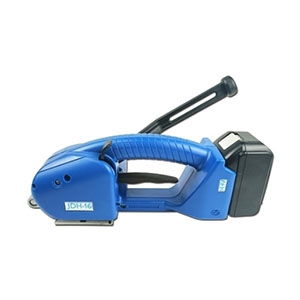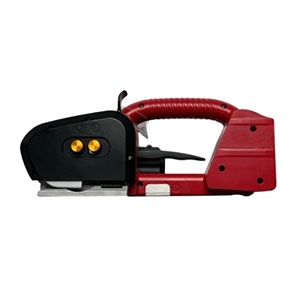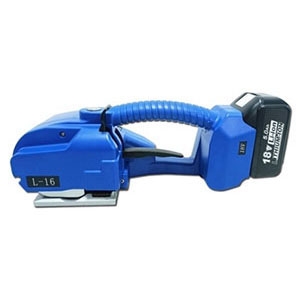The banding tool is a kind of mechanical equipment widely used in all walks of life, mainly used to bind, fix, and protect items with strapping straps, to facilitate storage, transportation, and sales. Its core function is to wrap the strapping tape around the product or package by mechanized means, tighten and connect the two ends through hot melting, wrapping, and other ways to form a firm strapping, to ensure that the items are not scattered during handling and storage, and the appearance is neat and beautiful. Here are some questions you might be concerned about.
Working Principle
Different types of banding tools differ in their specific operations, but their basic workflow and the function of the core components are common. The basic workflow is as follows:
- Item placement: Place the item to be packed on the table or conveyor belt of the banding tools to ensure that its position meets the packaging requirements.
- Insert of strapping belt: Start the banding tool, the machine automatically or manually inserts the strapping belt, and forms a strapping circle around the item.
- Tightening: The tightening device tightens the strapping belt and brings it close to the surface of the item to ensure that the strapping is firm.
- Sealing: Connect and fix the two ends of the binding belt using a hot-melting, ultrasonic, or mechanical buckle.
- Cut off: After sealing, the cutter device will cut off the excess strapping tape to complete a packing cycle.
Types and Applications
To better understand the various types of banding tools, their features, and applications, it's helpful to break them down according to their specific functions and the packaging needs they fulfill. These tools are designed to meet different production scales, from small operations to large industrial applications. Whether you need a simple tool for light packaging or a more advanced machine for large-scale, high-tension bundling, there’s a banding tool to fit every requirement. Below, we explore the distinct types of banding tools and their respective features and applications.
Manual Banding Tool
It is a straightforward, easy-to-operate device that is compact and lightweight, making it a great option for businesses with limited space. It doesn't require complex training or extensive technical knowledge, making it highly accessible for operators with minimal experience. Its small size also makes it highly portable and suitable for various locations within a facility. Despite its simplicity, the tool is effective for basic banding tasks with minimal setup.
The manual banding tool is ideal for small-scale operations, particularly in industries that deal with small and medium-weight packing boxes. It's commonly used in small businesses or on occasions where packaging demands are lower and volume isn't as high. Whether used for retail products or smaller shipments, manual banding tools are a practical solution for light packaging requirements.

Semi-automatic Strapping Machine
This kind of equipment combines manual and automatic elements, providing more efficiency than manual tools while still allowing for operator input. With this type, the packing belt must be manually inserted into the machine, but once the belt is in place, the machine takes over, automatically tightening, sealing, and cutting the strap. The process is much quicker than manual methods, reducing operator fatigue and increasing consistency in results. Semi-automatic banding tools generally come with adjustable tension settings to suit different packaging requirements, making them versatile for various applications.
A semi-automatic strapping tool is well-suited for medium-scale packaging needs, where a balance between automation and manual operation is required. It is commonly found in small and medium-sized enterprises that handle a higher volume of products but are not yet ready to invest in fully automated systems. It's perfect for packaging a range of products in varying sizes and weights, making it a flexible choice for production lines in diverse industries, including food processing, e-commerce, and distribution.

Automatic Banding Tool
It takes the concept of efficiency to the next level by eliminating the need for any manual intervention. Once the packing material is placed into the system, the machine autonomously completes feeding, tightening, sealing, and cutting the banding material. This automation results in higher speed and consistent packaging quality, with minimal room for human error. Automatic banding tools typically come equipped with sensors and advanced control systems, ensuring that the entire process is seamless and well-coordinated. These machines also tend to have a higher production capacity, making them ideal for industries where large volumes of products need to be packaged quickly and uniformly.
Automatic banding machines are perfect for large-scale production environments, including high-output manufacturing lines, distribution centers, and logistics hubs. They are especially useful in industries that require high-volume packaging with consistent quality, such as automotive manufacturing, electronics assembly, and large-scale retail operations. By reducing the need for manual labor and increasing packaging efficiency, automatic banding tools help these industries streamline their processes and increase productivity.

Pneumatic Strapping Tool
It operates using compressed air, making it highly efficient and capable of generating a significant amount of force. This system is known for producing high tension, which ensures that the packaging material is tightly secured around the product. Its operation is relatively simple, requiring minimal physical effort from the operator, as the compressed air powers the tool. Pneumatic systems also allow for more consistent performance, especially in environments where speed and reliability are key. These tools are designed for durability and can be used continuously, making them suitable for high-demand tasks.
The pneumatic ones are ideal for packaging situations that require high tension, such as bundling heavy or bulky items. They are commonly used in industries like logistics, shipping, and manufacturing, where large, heavy products need to be securely strapped, such as in the packaging of steel, wooden pallets, or large industrial goods. Their power and efficiency make them perfect for environments where heavy-duty bundling is required, ensuring secure, tight, and uniform packaging.
Note:
- Safety First: Before any maintenance work, be sure to turn off the main power supply and wait for the machine to completely stop running to ensure safe operation.
- Regular Training: Operation and maintenance personnel are regularly trained to improve their operational skills and maintenance level to ensure the effectiveness of maintenance work.
- Record Maintenance Logs: Establish detailed maintenance records, record the content, time, and person in charge of each maintenance, to track and analyze the running status of the machine.
Through the above detailed maintenance and maintenance measures, the service life of the banding tool can be effectively extended, to ensure its long-term stable operation, and to provide a reliable guarantee for production and logistics.
Ready to explore banding tool options or the banding tool price list? Head to Tool.com for instant access to detailed lists, expert reviews, and everything you need. Your ultimate guide is just a click away!

